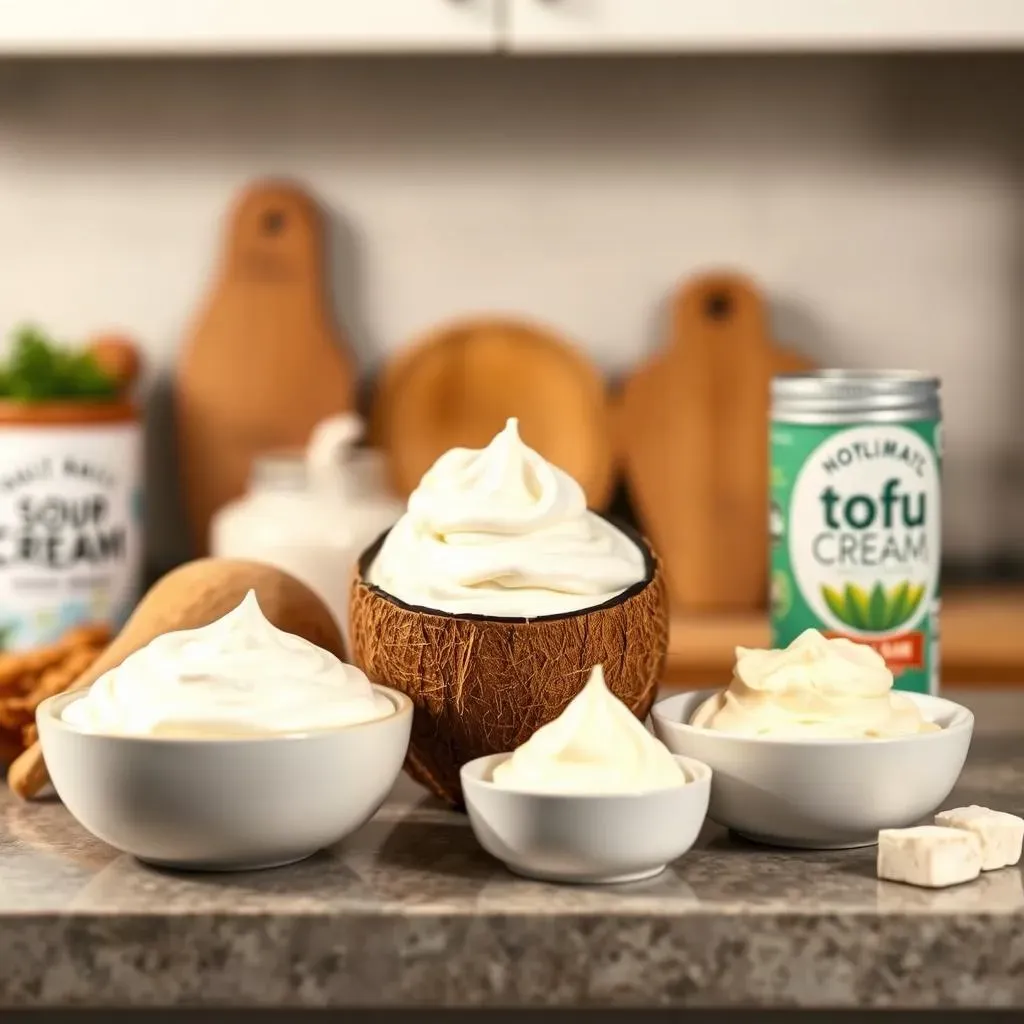Table of Contents
Ever found yourself mid-recipe, reaching for that dollop of sour cream, only to discover an empty container? It's a kitchen crisis we've all faced. But don't fret! This article is your guide to navigating that creamy conundrum. We'll explore several fantastic options for "what's a substitute for sour cream", whether you're baking a cake, whipping up a dip, or topping your tacos. We'll start with the usual suspects in the dairy aisle, like Greek yogurt and cream cheese, and then venture into some surprising non-dairy contenders. You'll learn not only what these substitutes are, but also how to use them effectively to achieve the best results. So, let's get started and make sure a missing tub of sour cream never ruins your meal again!
Why You Might Need a Sour Cream Substitute

Why You Might Need a Sour Cream Substitute
The "Oops, I'm Out!" Moment
Let's be real, we've all been there. You're in the middle of cooking, the recipe calls for sour cream, and bam – the fridge is bare. It's like the universe is testing your culinary skills. Maybe you forgot to add it to the shopping list, or perhaps a hungry family member beat you to the last spoonful. Whatever the reason, that empty container can throw a wrench in your plans. But this isn't the end of the world, it just means it's time to get creative.
This is where the magic of substitution comes in. Instead of abandoning your recipe, you can reach for a handy alternative. The goal is to keep the recipe on track without sacrificing flavor or texture. The good thing is, there's plenty of options, and they are not far away.
Dietary Restrictions and Preferences
It's not always about running out; sometimes, it's about what your body needs. Maybe you're lactose intolerant, or you're following a vegan diet. Traditional sour cream is a no-go in those cases. Luckily, the world of food has expanded. We now have a variety of substitutes that cater to different dietary needs and preferences. For instance, plant-based yogurts and creams can step in to save the day.
These alternatives aren't just replacements; they often bring their own unique twist. They allow you to enjoy your favorite dishes without compromising your health or beliefs. It's about inclusivity in the kitchen. It's about making sure everyone can enjoy the meal.
Dietary Need | Why Sour Cream is a Problem | Potential Substitute |
|---|---|---|
Lactose Intolerance | Contains lactose, which can cause digestive issues | Dairy-free yogurt, Tofu cream |
Vegan | Made from dairy, an animal product | Coconut cream, Cashew cream |
Low-Fat | High in fat content | Greek Yogurt, Light cream cheese |
Exploring New Flavors and Textures
Sometimes, using a substitute is not about need, but about adventure. You might be curious about how a different ingredient can change your dish. Perhaps you want to add a tangy twist with Greek yogurt or a richer feel with crème fraîche. Maybe you want to experiment with vegan options. It's about more than just replacing sour cream, it's about exploring new flavor profiles.
Substituting opens up a world of culinary possibilities. It encourages you to think outside the box and become more inventive in the kitchen. It’s not just about fixing a problem, it’s about enhancing your cooking.
Top Dairy Swaps: What's a Substitute for Sour Cream

Top Dairy Swaps: What's a Substitute for Sour Cream
Greek Yogurt: The Tangy Champion
Alright, let's talk about Greek yogurt. This stuff is a superstar when it comes to replacing sour cream. It’s thick, it’s creamy, and it has that signature tang that makes it a great match. I use it all the time in dips, salad dressings, and even as a topping for tacos. Seriously, you can swap it one-to-one in most recipes, and you’ll barely notice a difference. Plus, you get an extra boost of protein, which is never a bad thing. It's like a secret weapon in my fridge.
Now, if you're looking for that extra creamy feel, go for the full-fat variety. It’ll get you closer to the texture of sour cream. But if you’re watching your fat intake, the lower-fat versions work just as well. You might just need to adjust your recipe a little bit. I’ve even used it in baking, and it comes out fantastic. It is versatile and easy to use, what's not to like?
Cream Cheese: The Rich and Decadent Option
Next up is cream cheese. This is a great choice if you want to add some richness to your dish. It’s not quite as tangy as sour cream, but the texture is spot-on. I find it works wonders in baking, especially for things like cheesecakes or frostings. It gives a really smooth and decadent result. Just remember, it's thicker than sour cream, so you might need to thin it out a bit with a splash of milk or lemon juice to get the consistency just right.
Cream cheese also works great in dips and sauces, where it adds a wonderful velvety texture. It’s a bit heavier than sour cream, so keep that in mind when you’re substituting. But if you're looking for that extra touch of indulgence, cream cheese is your best friend. I sometimes even use it to make a quick creamy pasta sauce. Seriously, it's a lifesaver.
Substitute | Flavor Profile | Texture | Best Use |
|---|---|---|---|
Greek Yogurt | Tangy | Thick and Creamy | Dips, Dressings, Toppings |
Cream Cheese | Mild, Rich | Smooth and Thick | Baking, Sauces, Dips |
Crème Fraîche | Rich, Tangy | Thick and Silky | Soups, Sauces, Toppings |
Beyond Dairy: Other Sour Cream Alternatives

Beyond Dairy: Other Sour Cream Alternatives
Coconut Cream: The Tropical Twist
Okay, let's step away from the dairy aisle for a bit. Coconut cream is a fantastic option, especially if you're looking for a vegan alternative. It’s super rich and creamy, which makes it a great stand-in for sour cream in many dishes. I love using it in curries and soups to add that velvety texture. You’ll want to use the thick part from a can of full-fat coconut milk, not the watery stuff. Chill the can in the fridge and then scoop out the solid cream from the top. It’s like magic how it transforms recipes. Just a heads up, it does have a slight coconut flavor, so keep that in mind when choosing your dishes.
I've found that coconut cream works particularly well in desserts too. It adds a unique tropical note that can elevate a simple cake or mousse. It’s not just a substitute; it’s an opportunity to explore new flavor combinations. Plus, it's so easy to use. Just open a can, chill it, and scoop out the goodness. It’s a versatile ingredient that deserves a spot in every kitchen.
Cashew Cream: The Nutty Delight
Another great non-dairy option is cashew cream. It’s made by blending soaked cashews with water until it’s smooth and creamy. I know it sounds a little out there, but trust me, it’s amazing. It’s neutral in flavor, so it won’t overpower your dish, and it has a beautiful, silky texture that’s similar to sour cream. I use it in everything from pasta sauces to dips. It’s also a great option for those who are allergic to soy or other dairy alternatives.
To make cashew cream, you’ll need to soak the cashews for a few hours, or even overnight. Then, just blend them with water until it's smooth. You can adjust the thickness by adding more or less water. It's a bit more work than just opening a can, but the result is worth it. It’s a versatile and healthy option that can transform your recipes. I’ve even used it to make a vegan version of potato salad, and it was a hit!
Substitute | Flavor Profile | Texture | Best Use |
|---|---|---|---|
Coconut Cream | Slightly sweet, Coconutty | Rich, Thick | Curries, Soups, Desserts |
Cashew Cream | Neutral, Mild | Silky, Smooth | Sauces, Dips, Vegan Dishes |
Tofu Cream | Neutral | Smooth, Creamy | Dips, Dressings, Baking |
Tofu Cream: The Unsung Hero
Last but not least, let’s talk about tofu. Yes, tofu! It might seem like an odd choice, but when blended, it becomes surprisingly creamy and smooth. It's a fantastic option for those who need a soy-based, dairy-free substitute. Tofu cream is incredibly versatile because its flavor is so neutral. It takes on the flavors of whatever you're cooking, making it a great blank canvas. I’ve used it in dips, dressings, and even in baking.
To make tofu cream, you'll need to use silken tofu, which is much softer than regular tofu. Just blend it until it’s smooth, and you’re good to go. You can add a bit of lemon juice or vinegar to give it a touch of tanginess, similar to sour cream. It's a healthy and affordable option, especially if you’re on a budget. I was skeptical at first, but now it's a staple in my kitchen. It's amazing how versatile tofu can be!
Using Substitutes: Tips and Tricks for Success

Using Substitutes: Tips and Tricks for Success
Taste as You Go
Alright, so you've got your substitute picked out, that's awesome! Now, before you go dumping it into your recipe, take a little taste. Seriously, a small spoonful can tell you a lot. Each substitute has its own unique flavor profile, and you want to make sure it complements what you're cooking. For example, if you're using Greek yogurt, you might want to add a touch of lemon juice to mimic the tanginess of sour cream. Or if you're using coconut cream, you might need to adjust the spices to balance out that coconutty flavor. It's all about tweaking things to get it just right.
I always start with a small amount, add it to my recipe, taste it, and then adjust from there. It's a bit like being a food scientist, experimenting until you get the perfect result. If it's a dip or sauce, I'll taste it multiple times, adding a pinch of salt here, a dash of vinegar there. Don't be afraid to experiment. It's your kitchen, after all. And remember, you can always add more, but it's harder to take it away. So start slow and taste often.
Adjusting for Texture
Texture is as important as flavor, especially when it comes to sour cream. It's that creamy, smooth texture that makes it so great in so many dishes. When you're using a substitute, you need to think about how it will affect the overall texture of your recipe. Some substitutes, like cream cheese, are much thicker than sour cream. In those cases, you might need to thin it out with a little milk or water to get the right consistency. On the flip side, some substitutes, like low-fat yogurt, might be a bit too thin. You can thicken them up by adding a little cornstarch or by using a full-fat variety.
I've learned that the best approach is to add the substitute gradually, mixing it in and checking the texture as you go. If it's too thick, a little liquid will usually do the trick. If it's too thin, a bit of cornstarch or even a dollop of mashed potatoes can help. It’s all about finding that perfect balance. And remember, the goal is to get as close to that original sour cream texture as possible, so don’t be afraid to play around until you’re happy with it.
Substitute | Texture Adjustment Tips |
|---|---|
Greek Yogurt | Use full-fat for richer texture; add a bit of lemon juice for tang |
Cream Cheese | Thin with milk or water if too thick |
Coconut Cream | Use the thick part from the top of the can; chill before using |
Cashew Cream | Adjust thickness by adding more or less water |
Tofu Cream | Blend until smooth; add lemon juice for tang |
Baking with Substitutes
Baking is a whole different ball game when it comes to substitutions. It’s not as simple as swapping one ingredient for another. You need to be a bit more careful. Sour cream adds moisture and richness to baked goods, so you need to choose a substitute that can do the same. I’ve found that cream cheese and full-fat Greek yogurt work well in most baking recipes. They add that moisture and richness without changing the flavor too much. But remember, every recipe is different, so you might need to experiment a little.
When using a substitute in baking, it’s crucial to measure accurately. Unlike cooking, where you can add a little of this and a little of that, baking is more of a science. Too much or too little of a substitute can throw off the texture and consistency of your baked goods. I usually start by substituting a small portion of the sour cream and then gradually increase it until I'm confident it will work. So, pay close attention and don't be afraid to try things out. It's all part of the fun of baking.
Don't Be Afraid to Experiment
The golden rule of cooking with substitutes is to not be afraid to experiment. Seriously, that's how you discover new favorites. You might find that you prefer the taste of Greek yogurt over sour cream in your dips, or that cashew cream makes the most amazing vegan frosting. It's all about finding what works best for you. And sometimes, you might make mistakes, but that's okay too. You can learn from them and adjust the next time.
I've had some epic substitution fails in my kitchen, but I've also discovered some amazing new recipes. So, don’t let fear hold you back. Step into the kitchen and have some fun with it. You might just surprise yourself with what you create. And who knows? Maybe you'll come up with the next great sour cream substitute. The possibilities are endless.